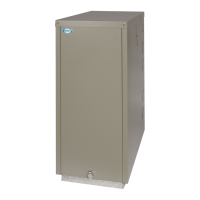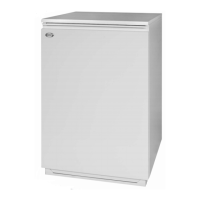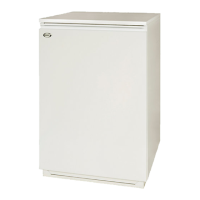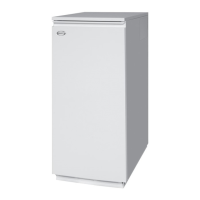18
Condensate
Disposal
6.6 Condensate Trap
Grant Vortex PRO boilers are supplied
with a factory-fitted condensate trap to
provide the required 75mm water seal
in the condensate discharge pipe from
the boiler.
This trap incorporates a float (which
will create a seal when the trap is
empty) and an overflow warning outlet
(fitted with a plastic sealing cap),
See Figure 6-2.
6.8 Inspection and Cleaning
of Trap
The trap must be checked at regular
intervals (e.g. on every annual service)
and cleaned as necessary to ensure
that it is clear and able to operate.
The bottom bowl is sealed to the trap
body and cannot be removed.
To inspect and clean the trap, perform
the following procedure:
1. Disconnect flexible condensate
hose from inlet connector.
2. Unscrew the inlet connection nut.
3. Remove the ‘top hat’ inlet
connector and nut from trap.
4. Remove trap from bracket.
5. Remove float from trap - clean if
necessary.
6. Inspect inside of trap and clean as
necessary.
7. Re-assemble trap, re-fit to boiler
and re-connect flexible hose. Ensure
that hose is fully pushed onto the
‘top hat’ inlet connector.
Failure to regularly check and clean
the condensate trap may result in
damage to the boiler and will not be
covered by the Product Warranty.
6.7 Condensate Disposal
Pipework
The condense trap outlet is at an angle
of 48° below the horizontal. This is to
automatically gives a 3° fall on any
‘horizontal’ runs of condense disposal
pipe. Refer to Fig.6-2 and see trap
outlet/pipe.
The outlet of the trap will accept
21.5mm OD to 23mm OD
Polypropylene overflow pipe for the
condensate discharge pipe.
Possible routes for disposal
pipework
The casing of the Vortex Pro External
boiler has several openings in both the
sides and base of the casing. These are
designed to allow pipework to pass
through the casing, as required, to suit
the installation. These openings can be
used to allow the condensate disposal
pipe to exit the casing in one of the
following ways:
Side outlet - The lower opening on
either side of the boiler casing can allow
the condensate disposal pipe to be
installed as follows:
• Connection to an internal stack -
passing back through the wall of the
house.
• Connection to an external soil stack
adjacent to the boiler.
• Discharge into an adjacent (external)
drain or gulley.
• Discharge into a soakaway - with
pipe either above or below ground
level.
Bottom outlet - There are three
openings in the base of the boiler casing
that can allow the condensate disposal
pipe to be installed as follows:
• Discharge into a drain or gulley
beneath the boiler (e.g. drain built in
to the concrete base for the boiler).
• Discharge into a soakaway - with
pipe below ground level.
The trap is factory-fitted inside the boiler
casing at the rear of the boiler -
mounted on the inside of the side panel
- in an accessible position to allow for
routine maintenance.
A flexible hose connects the outlet of
the condensing heat exchanger to the
trap inlet. Ensure the straight connector
on the hose is fully pushed onto the ‘top
hat’ inlet connector of the trap.
With the trap fitted inside the boiler
casing, the sealing cap must be fitted in
the trap outlet.
Care should be taken when siting the
trap such that the overflow outlet is
readily visible and that any
condensate overflowing from the
outlet cannot cause either a hazard
to persons or damage to surrounding
property or equipment.
6 Condensate Disposal
Figure 6-2: Condensate trap
!
NOTE
!
NOTE
!
WARNING
Sealing
cap must
be fitted
Flexible
hose from
outlet of
condensing
heat
exchanger
Condensate
trap
Condensate
outlet to
drain

